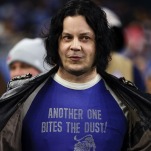The Greatest

A young man dies in a car accident at the beginning of The Greatest, and for the rest of the movie, his loved ones grieve for him. There’s a candor to writer-director Shana Feste’s melodrama that’s alternately bracing and awkward, a willingness to plumb directly into matters of loss and reconciliation where other indies might enter through the side door. Because it’s so straightforward, how much The Greatest works relies entirely on the verity of Feste’s observations and the cast’s ability to carry these volcanic emotions across. In the smallest of moments, it can be profoundly affecting, like an early scene where the mother, waking up after a nap, begins sobbing uncontrollably as she slips back into consciousness. It’s when the small moments become large ones that Feste overreaches and the shaky performances don’t bail her out.





![Rob Reiner's son booked for murder amid homicide investigation [Updated]](https://img.pastemagazine.com/wp-content/avuploads/2025/12/15131025/MixCollage-15-Dec-2025-01-10-PM-9121.jpg)

























![HBO teases new Euphoria, Larry David, and much more in 2026 sizzle reel [Updated]](https://img.pastemagazine.com/wp-content/avuploads/2025/12/12100344/MixCollage-12-Dec-2025-09-56-AM-9137.jpg)








